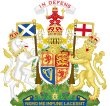Lord Clerk Register facts for kids
Quick facts for kids Lord Clerk Register |
|
|---|---|

Royal Coat of Arms of the United Kingdom in Scotland
|
|
| Appointer | Monarch of the United Kingdom |
| Salary | none |
The Lord Clerk Register is a very old and important job in Scotland. It's one of the oldest "Great Officers of State," which are special roles that help the King or Queen. This job started way back in the 1200s!
Long ago, the Lord Clerk Register was in charge of keeping all the important public records for Scotland. Think of it like being the main librarian and archivist for the whole country. Today, other people handle these duties. They are the Keeper of the National Records of Scotland and the Keeper of the Registers of Scotland.
Contents
History of This Important Job
In the Kingdom of Scotland
The job first appeared in 1288. It was called the 'Clerk of the Rolls of the Kings Chapel'. Later, in 1291, it became the 'Keeper of the Rolls of the Kingdom of Scotland'.
After the Wars of Scottish Independence, a similar role appeared. It was called 'Clerk of the Rolls'. Around 1373, the name changed to 'Clerk of the Rolls and Register'. The 'register' part meant keeping records of "charters." Charters were official documents, like grants of land or noble titles, sealed with the King's Great Seal.
At first, the Clerk of Rolls and Register looked after records for the King's office, Parliament, and the money department. But as the main civil court grew in the 1400s, this person also became responsible for its records. By 1483, the job was called 'Clerk of the Rolls, Register and Council'. This court later became the Court of Session, which is still an important court today.
By the 1400s, the Clerk Register was a high-ranking state officer. They had a seat in Parliament and the King's council. In the 1500s and 1600s, people started using more fancy names like 'Lord Register' or 'Lord Clerk Register'. This person continued to look after records for Parliament, the money department, and the Court of Session. New laws in the late 1500s added more duties. For example, the important Register of Sasines (records of land ownership) was put under their control in 1617.
By 1707, when Scotland joined with England, the job had a very long name! Since 1488, the King or Queen has chosen who gets this job.
In Great Britain
When Scotland and England joined to form Great Britain in 1707, they agreed to keep Scotland's public records safe. The Lord Clerk Register also became responsible for helping to elect the 16 Scottish representative peers who went to the new British Parliament in London.
However, Scotland no longer had its own Parliament or Privy Council. This meant many of the Lord Clerk Register's duties became much smaller. They mainly looked after court records and other legal documents.
In the United Kingdom
In 1806, a new role was created: the Deputy Clerk Register. This person took over most of the Lord Clerk Register's daily tasks. This made the Lord Clerk Register's job mostly an honorary title. In 1817, the Lord Clerk Register's office was combined with the Keeper of the Signet.
In 1818, the Lord Clerk Register and other state officers were given the important job of looking after the Honours of Scotland. These are Scotland's crown, sceptre, and sword, which are like the royal jewels.
In 1854, the Deputy Clerk Register's duties grew again. They became responsible for keeping records of births, deaths, and marriages in Scotland. This led to the creation of the General Registry Office.
In 1879, a law confirmed that the Lord Clerk Register would remain a ceremonial "Great Officer of State." All the actual work passed to the Deputy Clerk Register. However, the Lord Clerk Register still had one important task: organizing the election of Scottish peers to the House of Lords. This duty continued until 1963.
In 1928, the Deputy Clerk Register job was removed. Its duties went to a new role called the Keeper of the Registers and Records of Scotland. But it soon became clear that one person couldn't handle both keeping records and keeping registers.
So, in 1948, a new law split these duties into two separate government organizations. Now, there is the Keeper of the Registers of Scotland and the Keeper of the National Records of Scotland. These two people manage Scotland's official records today.
The Job Today
In 1996, the people in charge of the Scottish royal items (called the Regalia) were given another special responsibility. They became responsible for the Stone of Destiny, or Stone of Scone, when it moved to Edinburgh.
The Lord Clerk Register is still one of the people who looks after the Regalia. They are also the Keeper of the Signet. This means the job is mostly ceremonial now, like a special tradition.
The Lord Clerk Register has a high rank in Scotland's official pecking order. They come after the First Minister and the Lord Justice-General. They rank before the Lord Advocate and Lord Justice-Clerk. The current Lord Clerk Register is Lady Elish Angiolini, who started in June 2023.
See also
- Registrar General for Scotland
- Lord Justice Clerk


